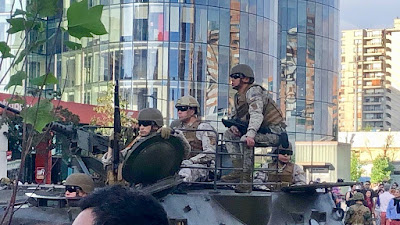 |
| Troops in Santiago earlier today attempting to quell riots Photo Martina Bennewitz Martinez |
GUEST BLOG: Macarena Rau Vargas
Macarena is an architect from Chile and the President of the International CPTED Association. She has a Ph.D. in architecture and urbanism and has led urban safety projects all across Latin America and the Carribean. She currently heads PBL Consulting, is an associate consultant with AlterNation LLC, and has led the evolution of 2nd Generation CPTED throughout South America. As a citizen of Chile, Macarena and her fellow citizens have suffered weeks of violent protests on the streets of Santiago. In this guest blog, she has a message for policymakers and citizens alike - a message that resonates in other countries around the world.
* * *
Rioters are burning factories, 11 people are dead, and over 10,000 police and troops are on the streets attempting to quell violent protests. These are times of social unrest in many countries and Chile is not immune. This very phenomenon was described in the first chapter of the SafeGrowth book: “We now see a resurgence of grassroots social movements calling for change… Do these increasing incidents of social unrest prophesize an impending future shock?”
In Santiago, it all started on October 18 when, as the result of a 4% Metro transit ticket hike, there was a spontaneous explosion of social discontent on the streets of Chile’s capital city. Even though wages in Chile have been slightly increasing and poverty falling, the rates of inequality remain high.
 |
| Bus burned by Chilean rioters after transit fare hike Photo by Jorge Morales Piderit, Wikimedia Commons |
At this very moment, it is important to reflect and ask what will lead us to a sustainable social peace both during crisis scenarios like this and in everyday life in Chile and throughout Latin America? Is there a methodology that allows us to realize that social peace?
THREE POINTS FOR CHANGE
The first point to establish is that public security is not improvised; rather it is the methodical result of concerted public, private and citizen efforts. And those efforts must be sustained to be able to deal with crises like those we suffer today in Chile, and in other Latin American countries. Creating stable and sustainable public policies is not a simple matter – they must integrate and articulate many parts of community justice and safety: control, prevention, reintegration, and victim care actions.
The second point is that before the public explodes in a burst of social discontent, a government must have the tools and capacity to diagnose socio-environmental pathologies that destroy the quality of public life. It must know how to diagnose, with the help of citizens, the possible threats to public life, whether those threats are internal or external. Governments are not always complicit in the creation of social inequity – it often happens because they are unaware of the full implications of even the simplest social policy – like a fare hike in a transit ticket! Again, this brings us to the need for a methodology to guide us forward.
We know from 20 years of work with both 1st and 2nd Generation Crime Prevention Through Environmental Design (CPTED) that we now have such a methodology. In Latin America, we call this the CPTED® methodology and it offers a social diagnosis that is co-produced with local communities. A CPTED® methodology diagnosis is not similar to the surveys, polling, or social research that governments too frequently rely on for information (and as we see in Santiago, often with disastrous results). The CPTED® methodology allows the diagnosis to be rich, relevant and up-to-date; it captures the pulse of community members and their real needs.
 |
| Santiago protesters take to the streets earlier today Photo Martina Bennewitz Martínez |
Our experience has taught us the more hyper-focused the diagnostics, the better the solutions. For example, we know from international evidence that the proportion of those who trigger violence during peaceful protests (resulting in riots) are a minority – often an organized and concerted minority – compared to the mass of citizens they claim to represent. No doubt social unrest and frustration exist. But few public citizens want to harm people, to burn stores, or destroy property. Few want people killed.
What citizens actually want is a solution to inequity, poverty, and a decent quality of life.
The third point is that public security policies must be in concert with various members of the community, both institutionally and socially; that is why citizen dialogue is fundamental. Dialogue must involve the citizenry, the armed forces, government, universities, civil society organizations, the church, and many others.
 |
| Modern, high-tech Santiago skyscrapers frame riot troops Photo Martina Bennewitz Martínez |
THE BACKBONE OF PEACE
Citizenship is the backbone that links both the SafeGrowth planning method recently introduced in North America and the broad style of CPTED® that we have developed in Latin America. Both methods employ citizenship at our core because we recognize its importance in developing public policy. Citizenship and the involvement of the public empowers citizens! That is how we end up with sustainable policies and avoid crucial public policy mistakes.
Likewise, in crisis scenarios as we see today, we must avoid polarizing talk that fractures people apart from a common ground. As the city of Bogotá demonstrated in the 1980s with its "Garrote and Carrot" policies, the balance between hard enforcement control was combined with the comprehensive social actions of the citizenry. This eventually cut the homicide rate in half.
Achieving sustainable social peace for Chile is possible, but it requires methodical changes based on evidence in public policies. This crisis is a call to turn the national helm in another direction. We expect both the government and the citizens of this country to walk in that direction.







